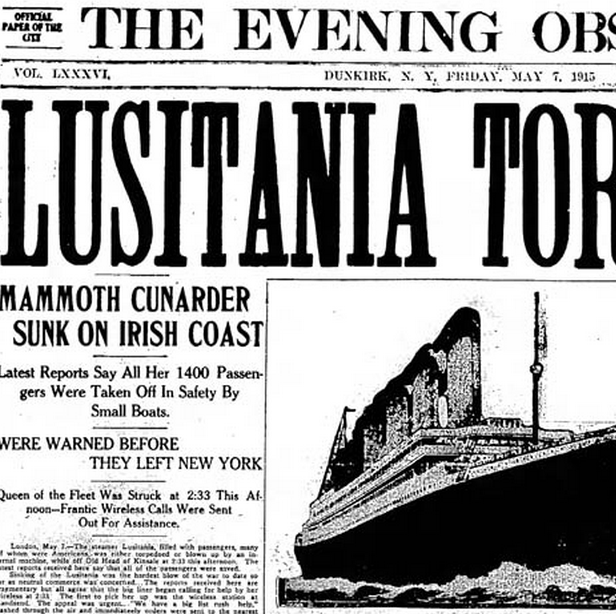On May 7, 1915, the news media reported that the British ocean liner Lusitania had been torpedoed by a World War I German U-boat off the coast of Ireland. More than 1,100 people died.
Here is a story excerpt from The Washington Post:
LONDON, May 8– The Cunard liner Lusitania, which sailed out of New York last Saturday with more than 2,000 souls aboard, lies at the bottom of the ocean off the Irish coast.
She was sunk by a German submarine, which sent two torpedoes crashing into her side while the passengers, seemingly confident that the great swift vessel could elude the German underwater craft, were having lunch.
….The British admiralty is discouraging the publication of surmises and guesses regarding the dead and injured. Even before the crude details are known the British press is asking editorially what the United States will say to this event and how she will hold Germany to the “strict accountability” mentioned in previous diplomatic correspondence.
Page one news from the Dunkirk (New York) Evening Observer:

![]()
The sinking of the Lusitania in 1915 is less widely known than the Titanic disaster three years earlier but in some ways it was more significant.
Much like its more famous counterpart, the Lusitania was large, luxurious and fast. In its home port of Liverpool, “Lusi” was also regarded as the jewel in the city’s crown.
….After war broke out in 1914, Germans faced food and fuel shortages due to its ports being blockaded by Britain’s Royal Navy.
The German navy wanted to retaliate against Britain, which continued to import supplies from the US. Their weapon of choice was submarines, known in German as Unterseeboot (undersea boat) or U-boot (U-boat).
In February 1915, Germany declared the seas around the British Isles a war zone.
“Allied vessels entering the zone were at risk,” Mr Murphy explains. “The German embassy placed a warning notice to passengers traveling on ships owned by Britain and her allies in 50 US newspapers.
“It was placed next to sailing notices for Lusitania in New York newspapers, which was taken as an indication that it was directed towards the ship.”
….It only took 18 minutes for the Lusitania to sink, compared to nearly three hours for the Titanic.
— “WW1 sinking of Lusitania recalled”
BBC News, March 2015
The National Archives has posted this film of the Lusitania leaving New York on May 1, 1915. As the film begins, we see the ship’s passengers arriving at the Cunard S.S. Company’s dock for their trip to England.
The Associated Press described some of the telegraph messages sent out about the ship:
….The news of her sinking was announced by the local office of the Cunard line, and was based on (telegraph) cables received from the home office of the company from Liverpool. Three dispatches, received in the order named were made public by the line and read as follows:
“We received from the Land’s End wireless station news of repeated distress calls made by the Lusitania asking for assistance immediately. Big list. Position ten miles south of Kinsale. Subsequently received telegram from Queenstown that all available craft in the harbor had been despatched to assist.
….Several boats, apparently survivors, southeast nine miles. Greek steamer proceeding to assist….”
This illustration comes from a staff artist at the Evening (Philadelphia) Ledger:







